warning BUICK TERRAZA 2005 Workshop Manual
[x] Cancel search | Manufacturer: BUICK, Model Year: 2005, Model line: TERRAZA, Model: BUICK TERRAZA 2005Pages: 428, PDF Size: 2.6 MB
Page 328 of 428
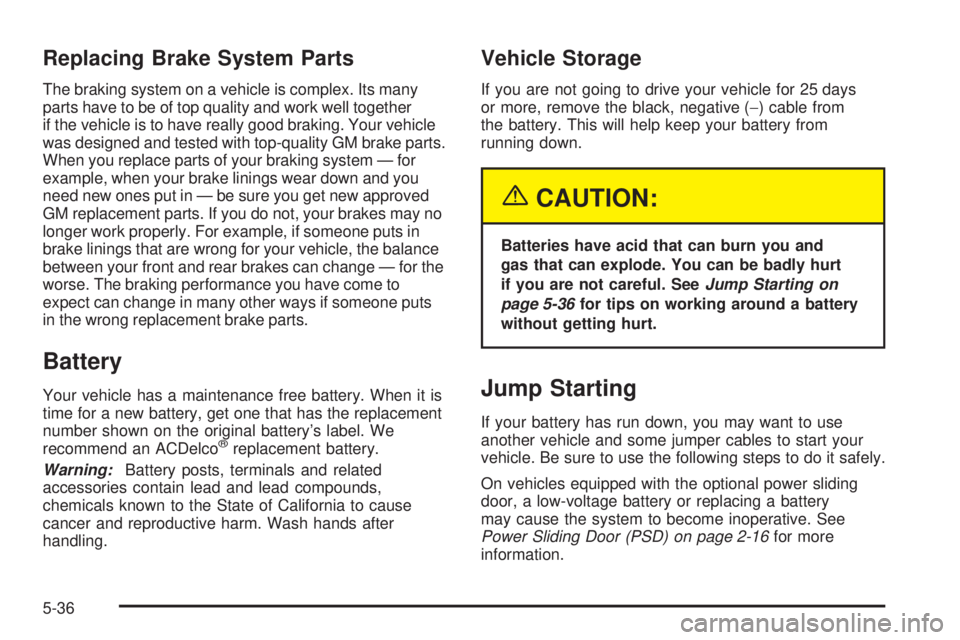
Replacing Brake System Parts
The braking system on a vehicle is complex. Its many
parts have to be of top quality and work well together
if the vehicle is to have really good braking. Your vehicle
was designed and tested with top-quality GM brake parts.
When you replace parts of your braking system — for
example, when your brake linings wear down and you
need new ones put in — be sure you get new approved
GM replacement parts. If you do not, your brakes may no
longer work properly. For example, if someone puts in
brake linings that are wrong for your vehicle, the balance
between your front and rear brakes can change — for the
worse. The braking performance you have come to
expect can change in many other ways if someone puts
in the wrong replacement brake parts.
Battery
Your vehicle has a maintenance free battery. When it is
time for a new battery, get one that has the replacement
number shown on the original battery’s label. We
recommend an ACDelco
®replacement battery.
Warning:Battery posts, terminals and related
accessories contain lead and lead compounds,
chemicals known to the State of California to cause
cancer and reproductive harm. Wash hands after
handling.
Vehicle Storage
If you are not going to drive your vehicle for 25 days
or more, remove the black, negative (−) cable from
the battery. This will help keep your battery from
running down.
{CAUTION:
Batteries have acid that can burn you and
gas that can explode. You can be badly hurt
if you are not careful. SeeJump Starting on
page 5-36for tips on working around a battery
without getting hurt.
Jump Starting
If your battery has run down, you may want to use
another vehicle and some jumper cables to start your
vehicle. Be sure to use the following steps to do it safely.
On vehicles equipped with the optional power sliding
door, a low-voltage battery or replacing a battery
may cause the system to become inoperative. See
Power Sliding Door (PSD) on page 2-16for more
information.
5-36
Page 349 of 428
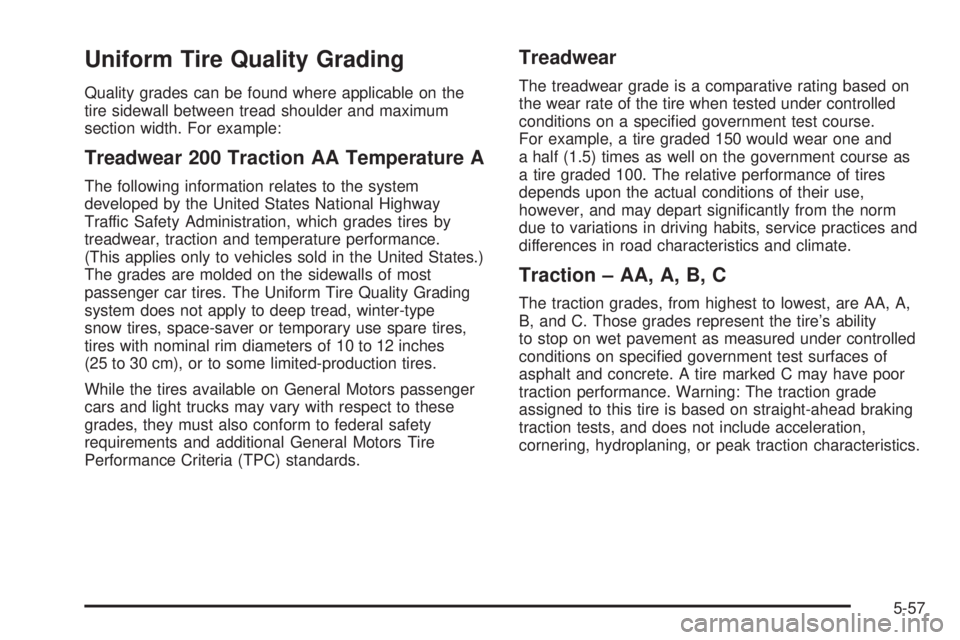
Uniform Tire Quality Grading
Quality grades can be found where applicable on the
tire sidewall between tread shoulder and maximum
section width. For example:
Treadwear 200 Traction AA Temperature A
The following information relates to the system
developed by the United States National Highway
Traffic Safety Administration, which grades tires by
treadwear, traction and temperature performance.
(This applies only to vehicles sold in the United States.)
The grades are molded on the sidewalls of most
passenger car tires. The Uniform Tire Quality Grading
system does not apply to deep tread, winter-type
snow tires, space-saver or temporary use spare tires,
tires with nominal rim diameters of 10 to 12 inches
(25 to 30 cm), or to some limited-production tires.
While the tires available on General Motors passenger
cars and light trucks may vary with respect to these
grades, they must also conform to federal safety
requirements and additional General Motors Tire
Performance Criteria (TPC) standards.
Treadwear
The treadwear grade is a comparative rating based on
the wear rate of the tire when tested under controlled
conditions on a speci�ed government test course.
For example, a tire graded 150 would wear one and
a half (1.5) times as well on the government course as
a tire graded 100. The relative performance of tires
depends upon the actual conditions of their use,
however, and may depart signi�cantly from the norm
due to variations in driving habits, service practices and
differences in road characteristics and climate.
Traction – AA, A, B, C
The traction grades, from highest to lowest, are AA, A,
B, and C. Those grades represent the tire’s ability
to stop on wet pavement as measured under controlled
conditions on speci�ed government test surfaces of
asphalt and concrete. A tire marked C may have poor
traction performance. Warning: The traction grade
assigned to this tire is based on straight-ahead braking
traction tests, and does not include acceleration,
cornering, hydroplaning, or peak traction characteristics.
5-57
Page 350 of 428
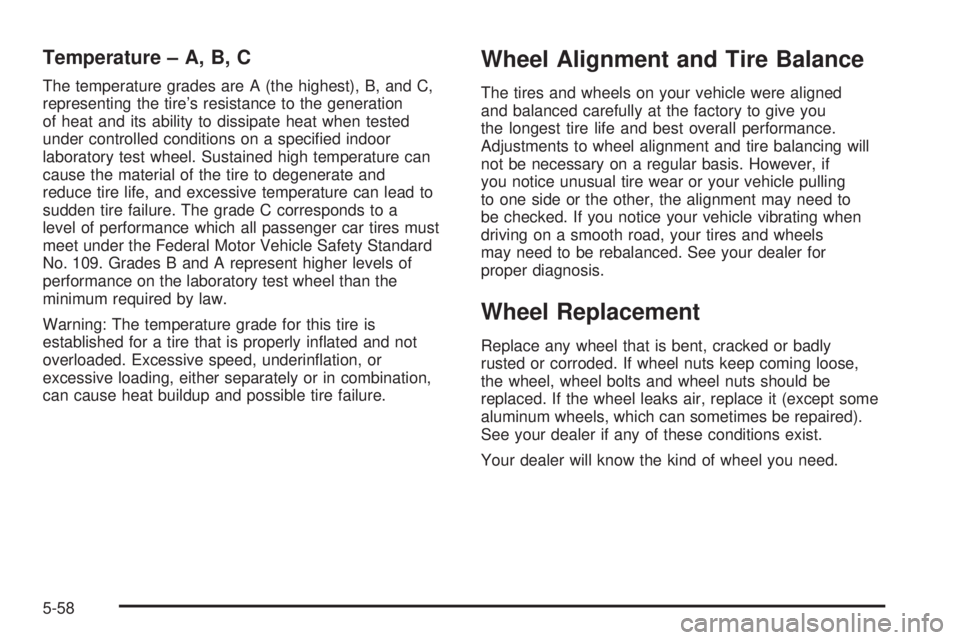
Temperature – A, B, C
The temperature grades are A (the highest), B, and C,
representing the tire’s resistance to the generation
of heat and its ability to dissipate heat when tested
under controlled conditions on a speci�ed indoor
laboratory test wheel. Sustained high temperature can
cause the material of the tire to degenerate and
reduce tire life, and excessive temperature can lead to
sudden tire failure. The grade C corresponds to a
level of performance which all passenger car tires must
meet under the Federal Motor Vehicle Safety Standard
No. 109. Grades B and A represent higher levels of
performance on the laboratory test wheel than the
minimum required by law.
Warning: The temperature grade for this tire is
established for a tire that is properly in�ated and not
overloaded. Excessive speed, underin�ation, or
excessive loading, either separately or in combination,
can cause heat buildup and possible tire failure.
Wheel Alignment and Tire Balance
The tires and wheels on your vehicle were aligned
and balanced carefully at the factory to give you
the longest tire life and best overall performance.
Adjustments to wheel alignment and tire balancing will
not be necessary on a regular basis. However, if
you notice unusual tire wear or your vehicle pulling
to one side or the other, the alignment may need to
be checked. If you notice your vehicle vibrating when
driving on a smooth road, your tires and wheels
may need to be rebalanced. See your dealer for
proper diagnosis.
Wheel Replacement
Replace any wheel that is bent, cracked or badly
rusted or corroded. If wheel nuts keep coming loose,
the wheel, wheel bolts and wheel nuts should be
replaced. If the wheel leaks air, replace it (except some
aluminum wheels, which can sometimes be repaired).
See your dealer if any of these conditions exist.
Your dealer will know the kind of wheel you need.
5-58
Page 354 of 428
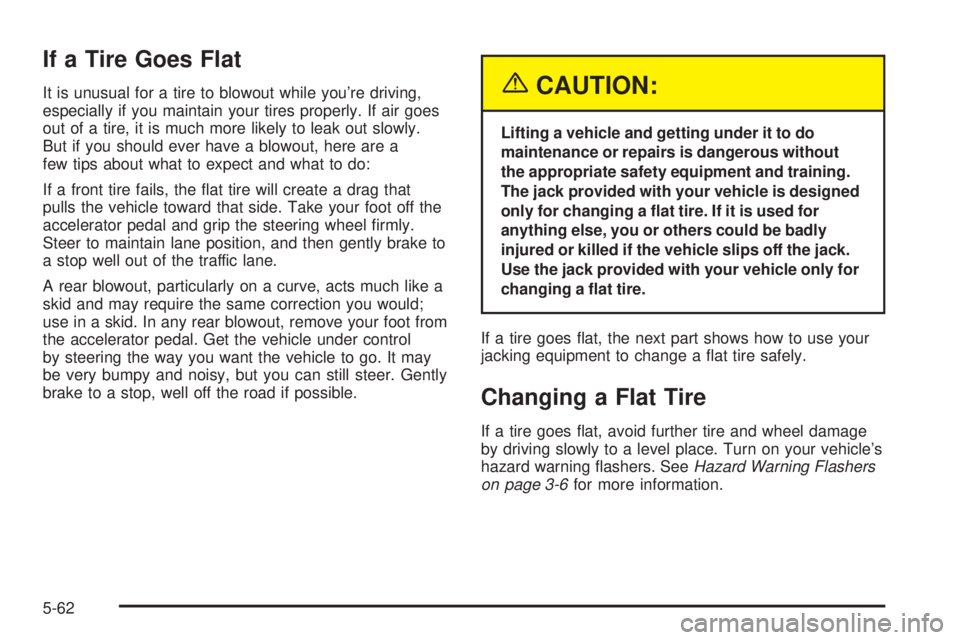
If a Tire Goes Flat
It is unusual for a tire to blowout while you’re driving,
especially if you maintain your tires properly. If air goes
out of a tire, it is much more likely to leak out slowly.
But if you should ever have a blowout, here are a
few tips about what to expect and what to do:
If a front tire fails, the �at tire will create a drag that
pulls the vehicle toward that side. Take your foot off the
accelerator pedal and grip the steering wheel �rmly.
Steer to maintain lane position, and then gently brake to
a stop well out of the traffic lane.
A rear blowout, particularly on a curve, acts much like a
skid and may require the same correction you would;
use in a skid. In any rear blowout, remove your foot from
the accelerator pedal. Get the vehicle under control
by steering the way you want the vehicle to go. It may
be very bumpy and noisy, but you can still steer. Gently
brake to a stop, well off the road if possible.{CAUTION:
Lifting a vehicle and getting under it to do
maintenance or repairs is dangerous without
the appropriate safety equipment and training.
The jack provided with your vehicle is designed
only for changing a �at tire. If it is used for
anything else, you or others could be badly
injured or killed if the vehicle slips off the jack.
Use the jack provided with your vehicle only for
changing a �at tire.
If a tire goes �at, the next part shows how to use your
jacking equipment to change a �at tire safely.
Changing a Flat Tire
If a tire goes �at, avoid further tire and wheel damage
by driving slowly to a level place. Turn on your vehicle’s
hazard warning �ashers. SeeHazard Warning Flashers
on page 3-6for more information.
5-62
Page 369 of 428
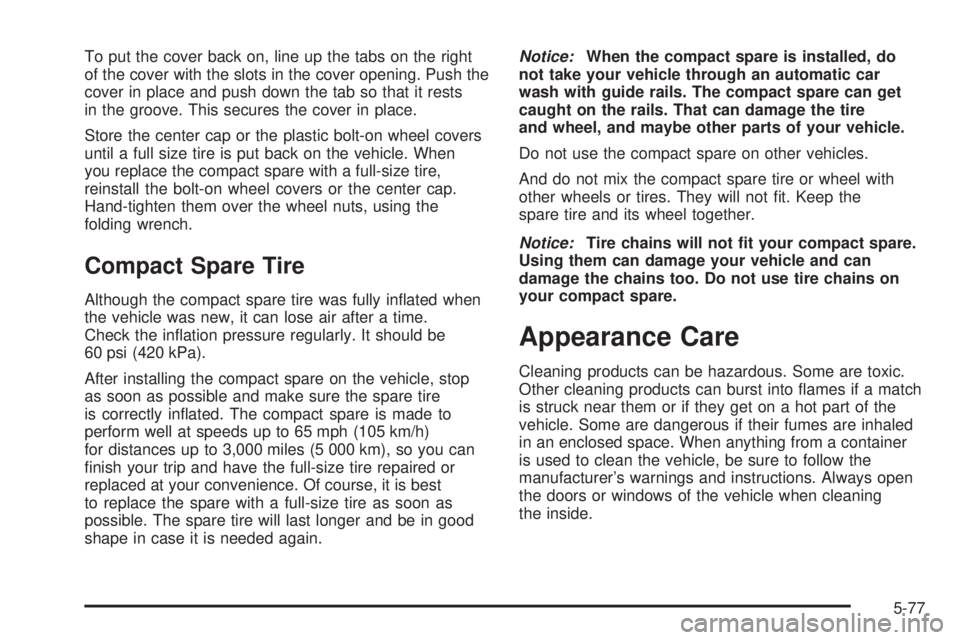
To put the cover back on, line up the tabs on the right
of the cover with the slots in the cover opening. Push the
cover in place and push down the tab so that it rests
in the groove. This secures the cover in place.
Store the center cap or the plastic bolt-on wheel covers
until a full size tire is put back on the vehicle. When
you replace the compact spare with a full-size tire,
reinstall the bolt-on wheel covers or the center cap.
Hand-tighten them over the wheel nuts, using the
folding wrench.
Compact Spare Tire
Although the compact spare tire was fully in�ated when
the vehicle was new, it can lose air after a time.
Check the in�ation pressure regularly. It should be
60 psi (420 kPa).
After installing the compact spare on the vehicle, stop
as soon as possible and make sure the spare tire
is correctly in�ated. The compact spare is made to
perform well at speeds up to 65 mph (105 km/h)
for distances up to 3,000 miles (5 000 km), so you can
�nish your trip and have the full-size tire repaired or
replaced at your convenience. Of course, it is best
to replace the spare with a full-size tire as soon as
possible. The spare tire will last longer and be in good
shape in case it is needed again.Notice:When the compact spare is installed, do
not take your vehicle through an automatic car
wash with guide rails. The compact spare can get
caught on the rails. That can damage the tire
and wheel, and maybe other parts of your vehicle.
Do not use the compact spare on other vehicles.
And do not mix the compact spare tire or wheel with
other wheels or tires. They will not �t. Keep the
spare tire and its wheel together.
Notice:Tire chains will not �t your compact spare.
Using them can damage your vehicle and can
damage the chains too. Do not use tire chains on
your compact spare.
Appearance Care
Cleaning products can be hazardous. Some are toxic.
Other cleaning products can burst into �ames if a match
is struck near them or if they get on a hot part of the
vehicle. Some are dangerous if their fumes are inhaled
in an enclosed space. When anything from a container
is used to clean the vehicle, be sure to follow the
manufacturer’s warnings and instructions. Always open
the doors or windows of the vehicle when cleaning
the inside.
5-77
Page 415 of 428
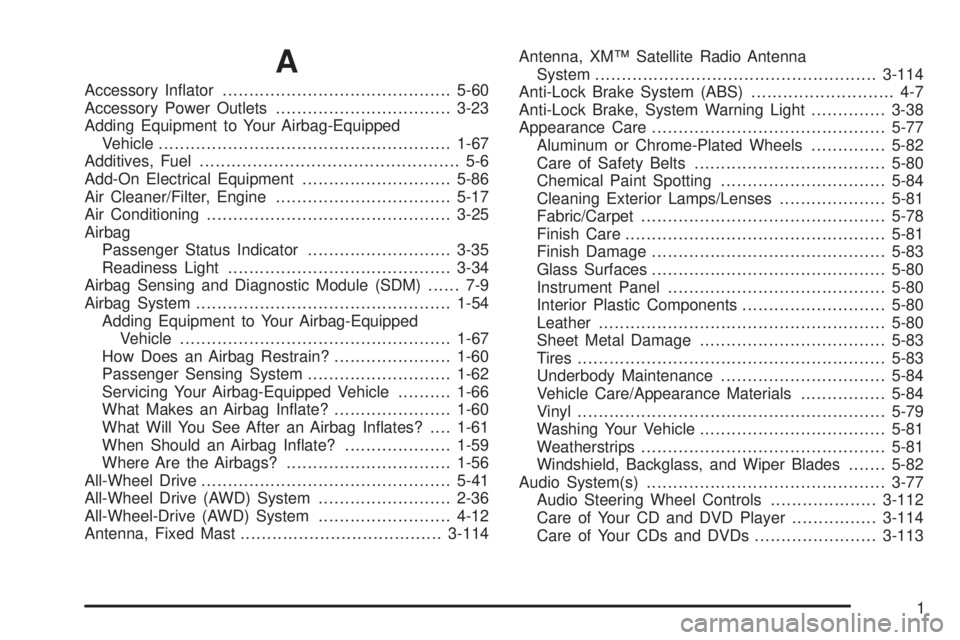
A
Accessory In�ator...........................................5-60
Accessory Power Outlets.................................3-23
Adding Equipment to Your Airbag-Equipped
Vehicle.......................................................1-67
Additives, Fuel................................................. 5-6
Add-On Electrical Equipment............................5-86
Air Cleaner/Filter, Engine.................................5-17
Air Conditioning..............................................3-25
Airbag
Passenger Status Indicator...........................3-35
Readiness Light..........................................3-34
Airbag Sensing and Diagnostic Module (SDM)...... 7-9
Airbag System................................................1-54
Adding Equipment to Your Airbag-Equipped
Vehicle...................................................1-67
How Does an Airbag Restrain?......................1-60
Passenger Sensing System...........................1-62
Servicing Your Airbag-Equipped Vehicle..........1-66
What Makes an Airbag In�ate?......................1-60
What Will You See After an Airbag In�ates?....1-61
When Should an Airbag In�ate?....................1-59
Where Are the Airbags?...............................1-56
All-Wheel Drive...............................................5-41
All-Wheel Drive (AWD) System.........................2-36
All-Wheel-Drive (AWD) System.........................4-12
Antenna, Fixed Mast......................................3-114Antenna, XM™ Satellite Radio Antenna
System.....................................................3-114
Anti-Lock Brake System (ABS)........................... 4-7
Anti-Lock Brake, System Warning Light..............3-38
Appearance Care............................................5-77
Aluminum or Chrome-Plated Wheels..............5-82
Care of Safety Belts....................................5-80
Chemical Paint Spotting...............................5-84
Cleaning Exterior Lamps/Lenses....................5-81
Fabric/Carpet..............................................5-78
Finish Care.................................................5-81
Finish Damage............................................5-83
Glass Surfaces............................................5-80
Instrument Panel.........................................5-80
Interior Plastic Components...........................5-80
Leather......................................................5-80
Sheet Metal Damage...................................5-83
Tires..........................................................5-83
Underbody Maintenance...............................5-84
Vehicle Care/Appearance Materials................5-84
Vinyl..........................................................5-79
Washing Your Vehicle...................................5-81
Weatherstrips..............................................5-81
Windshield, Backglass, and Wiper Blades.......5-82
Audio System(s).............................................3-77
Audio Steering Wheel Controls....................3-112
Care of Your CD and DVD Player................3-114
Care of Your CDs and DVDs.......................3-113
1
Page 416 of 428
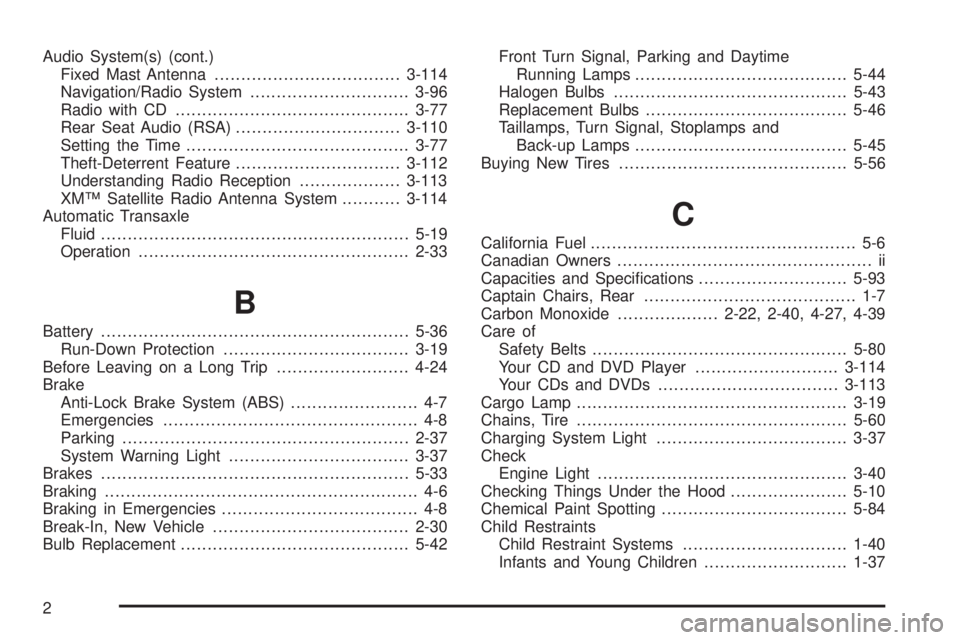
Audio System(s) (cont.)
Fixed Mast Antenna...................................3-114
Navigation/Radio System..............................3-96
Radio with CD............................................3-77
Rear Seat Audio (RSA)...............................3-110
Setting the Time..........................................3-77
Theft-Deterrent Feature...............................3-112
Understanding Radio Reception...................3-113
XM™ Satellite Radio Antenna System...........3-114
Automatic Transaxle
Fluid..........................................................5-19
Operation...................................................2-33
B
Battery..........................................................5-36
Run-Down Protection...................................3-19
Before Leaving on a Long Trip.........................4-24
Brake
Anti-Lock Brake System (ABS)........................ 4-7
Emergencies................................................ 4-8
Parking......................................................2-37
System Warning Light..................................3-37
Brakes..........................................................5-33
Braking........................................................... 4-6
Braking in Emergencies..................................... 4-8
Break-In, New Vehicle.....................................2-30
Bulb Replacement...........................................5-42Front Turn Signal, Parking and Daytime
Running Lamps........................................5-44
Halogen Bulbs............................................5-43
Replacement Bulbs......................................5-46
Taillamps, Turn Signal, Stoplamps and
Back-up Lamps........................................5-45
Buying New Tires...........................................5-56
C
California Fuel.................................................. 5-6
Canadian Owners................................................ ii
Capacities and Speci�cations............................5-93
Captain Chairs, Rear........................................ 1-7
Carbon Monoxide...................2-22, 2-40, 4-27, 4-39
Care of
Safety Belts................................................5-80
Your CD and DVD Player...........................3-114
Your CDs and DVDs..................................3-113
Cargo Lamp...................................................3-19
Chains, Tire...................................................5-60
Charging System Light....................................3-37
Check
Engine Light...............................................3-40
Checking Things Under the Hood......................5-10
Chemical Paint Spotting...................................5-84
Child Restraints
Child Restraint Systems...............................1-40
Infants and Young Children...........................1-37
2
Page 418 of 428
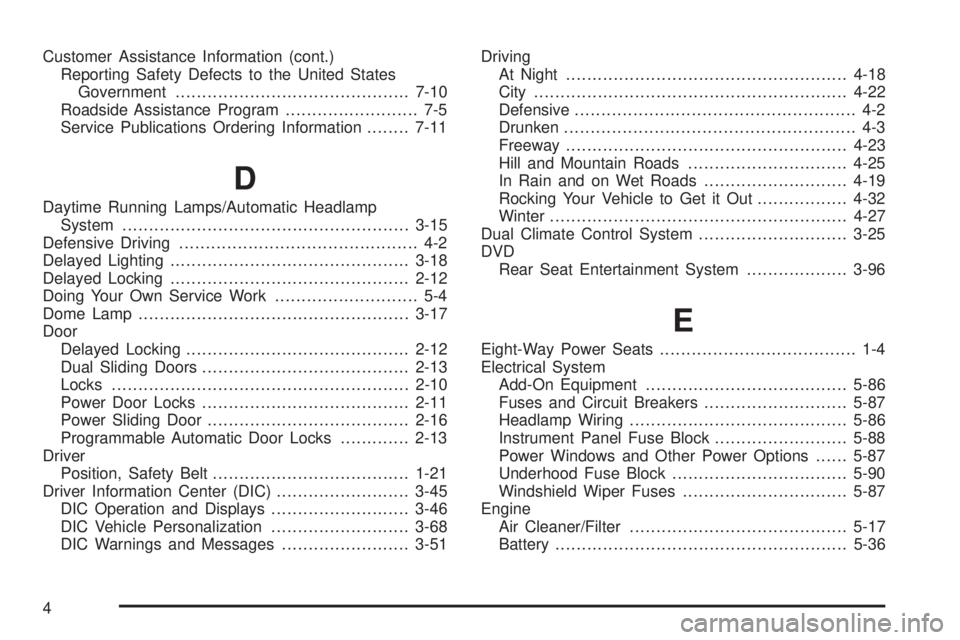
Customer Assistance Information (cont.)
Reporting Safety Defects to the United States
Government............................................7-10
Roadside Assistance Program......................... 7-5
Service Publications Ordering Information........7-11
D
Daytime Running Lamps/Automatic Headlamp
System......................................................3-15
Defensive Driving............................................. 4-2
Delayed Lighting.............................................3-18
Delayed Locking.............................................2-12
Doing Your Own Service Work........................... 5-4
Dome Lamp...................................................3-17
Door
Delayed Locking..........................................2-12
Dual Sliding Doors.......................................2-13
Locks........................................................2-10
Power Door Locks.......................................2-11
Power Sliding Door......................................2-16
Programmable Automatic Door Locks.............2-13
Driver
Position, Safety Belt.....................................1-21
Driver Information Center (DIC).........................3-45
DIC Operation and Displays..........................3-46
DIC Vehicle Personalization..........................3-68
DIC Warnings and Messages........................3-51Driving
At Night.....................................................4-18
City...........................................................4-22
Defensive..................................................... 4-2
Drunken....................................................... 4-3
Freeway.....................................................4-23
Hill and Mountain Roads..............................4-25
In Rain and on Wet Roads...........................4-19
Rocking Your Vehicle to Get it Out.................4-32
Winter........................................................4-27
Dual Climate Control System............................3-25
DVD
Rear Seat Entertainment System...................3-96
E
Eight-Way Power Seats..................................... 1-4
Electrical System
Add-On Equipment......................................5-86
Fuses and Circuit Breakers...........................5-87
Headlamp Wiring.........................................5-86
Instrument Panel Fuse Block.........................5-88
Power Windows and Other Power Options......5-87
Underhood Fuse Block.................................5-90
Windshield Wiper Fuses...............................5-87
Engine
Air Cleaner/Filter.........................................5-17
Battery.......................................................5-36
4
Page 419 of 428

Engine (cont.)
Check and Service Engine Soon Light............3-40
Coolant......................................................5-21
Coolant Heater............................................2-32
Coolant Temperature Gage...........................3-39
Engine Compartment Overview......................5-12
Exhaust.....................................................2-40
Oil .............................................................5-13
Oil Life System...........................................5-16
Overheated Protection Operating Mode...........5-26
Overheating................................................5-24
Starting......................................................2-31
Entry Lighting.................................................3-17
Event Data Recorders (EDR)............................. 7-9
Exit Lighting...................................................3-18
Extender, Safety Belt.......................................1-34
Exterior Lamps...............................................3-14
F
Filter
Engine Air Cleaner......................................5-17
Finish Damage...............................................5-83
Fixed Mast Antenna.......................................3-114
Flash-to-Pass................................................... 3-8Flat Tire........................................................5-62
Flat Tire, Changing.........................................5-62
Flat Tire, Storing.............................................5-74
Fluid
Automatic Transaxle.....................................5-19
Power Steering...........................................5-32
Windshield Washer......................................5-32
Folding Tray...................................................2-51
Front Console Storage Area.............................2-50
Front Reading Lamps......................................3-19
Fuel............................................................... 5-5
Additives...................................................... 5-6
California Fuel.............................................. 5-6
Filling a Portable Fuel Container....................5-10
Filling Your Tank........................................... 5-8
Fuels in Foreign Countries.............................. 5-7
Gage.........................................................3-44
Gasoline Octane........................................... 5-5
Gasoline Speci�cations.................................. 5-5
Low Warning Light.......................................3-44
Fuses
Fuses and Circuit Breakers...........................5-87
Instrument Panel Fuse Block.........................5-88
Underhood Fuse Block.................................5-90
Windshield Wiper.........................................5-87
5
Page 420 of 428
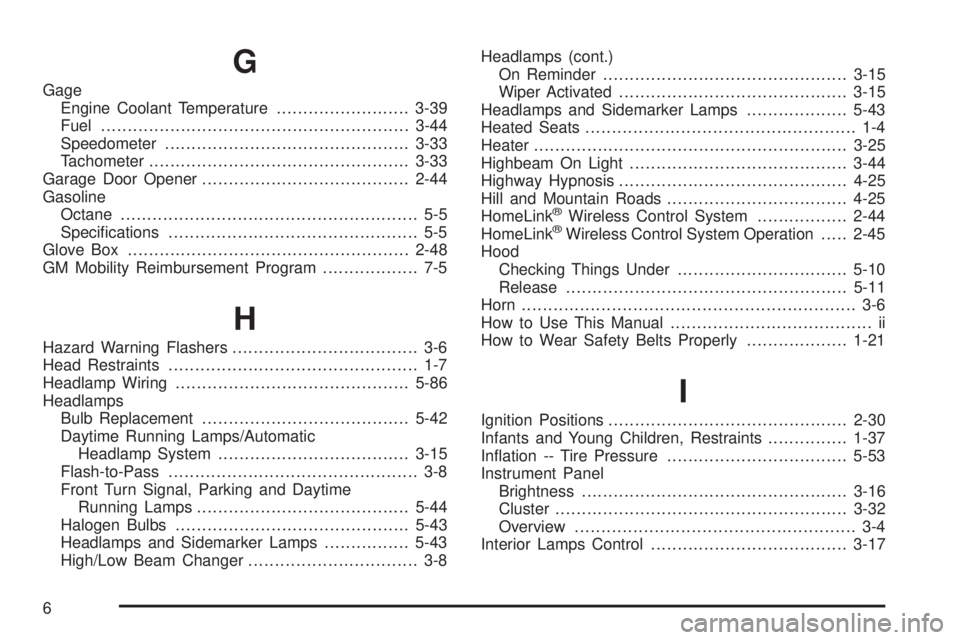
G
Gage
Engine Coolant Temperature.........................3-39
Fuel..........................................................3-44
Speedometer..............................................3-33
Tachometer.................................................3-33
Garage Door Opener.......................................2-44
Gasoline
Octane........................................................ 5-5
Speci�cations............................................... 5-5
Glove Box.....................................................2-48
GM Mobility Reimbursement Program.................. 7-5
H
Hazard Warning Flashers................................... 3-6
Head Restraints............................................... 1-7
Headlamp Wiring............................................5-86
Headlamps
Bulb Replacement.......................................5-42
Daytime Running Lamps/Automatic
Headlamp System....................................3-15
Flash-to-Pass............................................... 3-8
Front Turn Signal, Parking and Daytime
Running Lamps........................................5-44
Halogen Bulbs............................................5-43
Headlamps and Sidemarker Lamps................5-43
High/Low Beam Changer................................ 3-8Headlamps (cont.)
On Reminder..............................................3-15
Wiper Activated...........................................3-15
Headlamps and Sidemarker Lamps...................5-43
Heated Seats................................................... 1-4
Heater...........................................................3-25
Highbeam On Light.........................................3-44
Highway Hypnosis...........................................4-25
Hill and Mountain Roads..................................4-25
HomeLink
®Wireless Control System.................2-44
HomeLink®Wireless Control System Operation.....2-45
Hood
Checking Things Under................................5-10
Release.....................................................5-11
Horn............................................................... 3-6
How to Use This Manual...................................... ii
How to Wear Safety Belts Properly...................1-21
I
Ignition Positions.............................................2-30
Infants and Young Children, Restraints...............1-37
In�ation -- Tire Pressure..................................5-53
Instrument Panel
Brightness..................................................3-16
Cluster.......................................................3-32
Overview..................................................... 3-4
Interior Lamps Control.....................................3-17
6